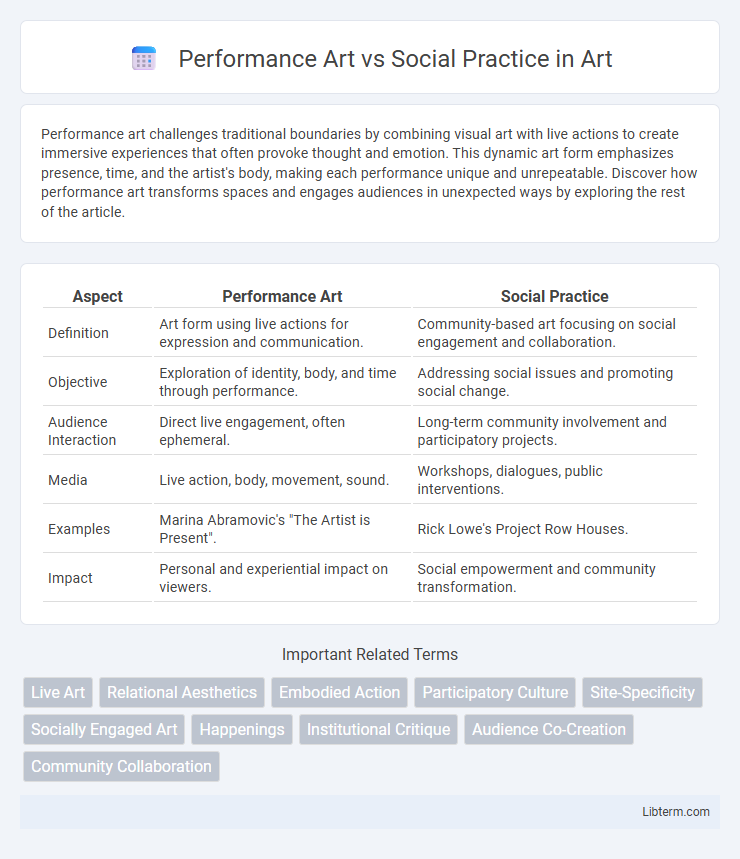Performance art challenges traditional boundaries by combining visual art with live actions to create immersive experiences that often provoke thought and emotion. This dynamic art form emphasizes presence, time, and the artist's body, making each performance unique and unrepeatable. Discover how performance art transforms spaces and engages audiences in unexpected ways by exploring the rest of the article.
Table of Comparison
| Aspect | Performance Art | Social Practice |
|---|---|---|
| Definition | Art form using live actions for expression and communication. | Community-based art focusing on social engagement and collaboration. |
| Objective | Exploration of identity, body, and time through performance. | Addressing social issues and promoting social change. |
| Audience Interaction | Direct live engagement, often ephemeral. | Long-term community involvement and participatory projects. |
| Media | Live action, body, movement, sound. | Workshops, dialogues, public interventions. |
| Examples | Marina Abramovic's "The Artist is Present". | Rick Lowe's Project Row Houses. |
| Impact | Personal and experiential impact on viewers. | Social empowerment and community transformation. |
Defining Performance Art
Performance Art is an interdisciplinary art form that combines visual art with dramatic performance, often emphasizing live, ephemeral actions by the artist. It challenges traditional boundaries by engaging the audience directly through time-based, physical expressions that can incorporate music, dance, and spoken word. Unlike Social Practice, which centers on community collaboration and social engagement, Performance Art prioritizes individual artistic expression and experiential impact within a controlled or staged environment.
Understanding Social Practice Art
Social Practice Art emphasizes community engagement and collaborative processes, prioritizing social interaction and participatory experiences over traditional aesthetics. This art form often addresses social issues, fostering dialogue and facilitating change through collective participation. Unlike Performance Art, which centers on individual expression and scripted or improvised acts, Social Practice Art integrates social dynamics as a core element of its creative methodology.
Historical Origins and Context
Performance art emerged in the early 20th century as an avant-garde movement rooted in Dadaism and Futurism, emphasizing ephemeral, live actions that challenged traditional art forms. Social practice art developed later in the 1960s and 1970s during the rise of community activism and political movements, focusing on collaborative, socially engaged projects that address cultural and societal issues. Both genres reflect historical contexts where artists sought to redefine the role of art in public life, shifting from object-based work to interactive, participatory experiences.
Key Characteristics of Performance Art
Performance Art emphasizes live, time-based actions by artists, often involving the body as a central medium to explore themes of identity, politics, and cultural critique. It is characterized by its ephemeral nature, direct audience engagement, and rejection of traditional art objects, prioritizing experience and process over permanence. This art form frequently incorporates improvisation, theatrical elements, and multimedia, challenging boundaries between artist and spectator.
Core Principles of Social Practice
Social Practice centers on community engagement, participatory interaction, and social change, emphasizing collaboration and collective impact over individual artistic expression. It prioritizes ethical considerations, inclusivity, and addressing social issues through art as a catalyst for dialogue and empowerment. Performance Art typically highlights personal expression and ephemeral experiences, whereas Social Practice integrates sustained community involvement and activism into its core principles.
Audience Engagement and Participation
Performance Art emphasizes direct, often ephemeral interaction where the audience witnesses or becomes a part of the unfolding artistic act, blurring the lines between observer and participant. Social Practice centers on community involvement and collaborative projects that address social issues, fostering sustained engagement and collective action beyond traditional art settings. Both forms prioritize meaningful audience participation but differ in scale and intent, with Performance Art focusing on immediate experience and Social Practice aiming for long-term societal impact.
Intent and Impact: Art vs Social Change
Performance art prioritizes individual expression and artistic innovation, aiming to evoke emotional or intellectual responses through live, ephemeral experiences. Social practice centers on community engagement and collaborative processes, intending to drive social change and foster dialogue around pressing societal issues. The impact of performance art often enriches cultural discourse, while social practice actively mobilizes participants toward tangible social transformation.
Notable Artists and Influential Works
Performance Art features notable artists such as Marina Abramovic, known for her endurance-based works like "The Artist is Present," and Yoko Ono, whose "Cut Piece" challenged audience interaction. Social Practice highlights influential figures including Theaster Gates, whose urban revitalization projects merge art with community engagement, and Rick Lowe, founder of Project Row Houses, emphasizing social transformation through collaborative art. Both disciplines emphasize experiential impact but diverge as Performance Art focuses on individual expression while Social Practice centers on collective action and societal change.
Challenges and Criticisms
Performance art often faces criticism for its ephemeral nature and perceived lack of lasting impact, challenging artists to create meaningful, memorable experiences. Social practice art grapples with ethical considerations and tensions around community engagement, including issues of representation, consent, and sustainability. Both forms confront difficulties in balancing artistic intent with audience interpretation, complicating their acceptance in traditional art institutions.
Future Directions and Evolving Boundaries
Performance Art and Social Practice increasingly integrate digital technologies and participatory media, expanding their reach and interactivity in public spaces. Emerging trends emphasize collaborative, community-driven projects that challenge traditional notions of authorship and audience engagement. Future directions suggest a fluid boundary where performance merges with activism, virtual reality, and immersive environments, fostering dynamic social change and cultural dialogue.
Performance Art Infographic

 libterm.com
libterm.com